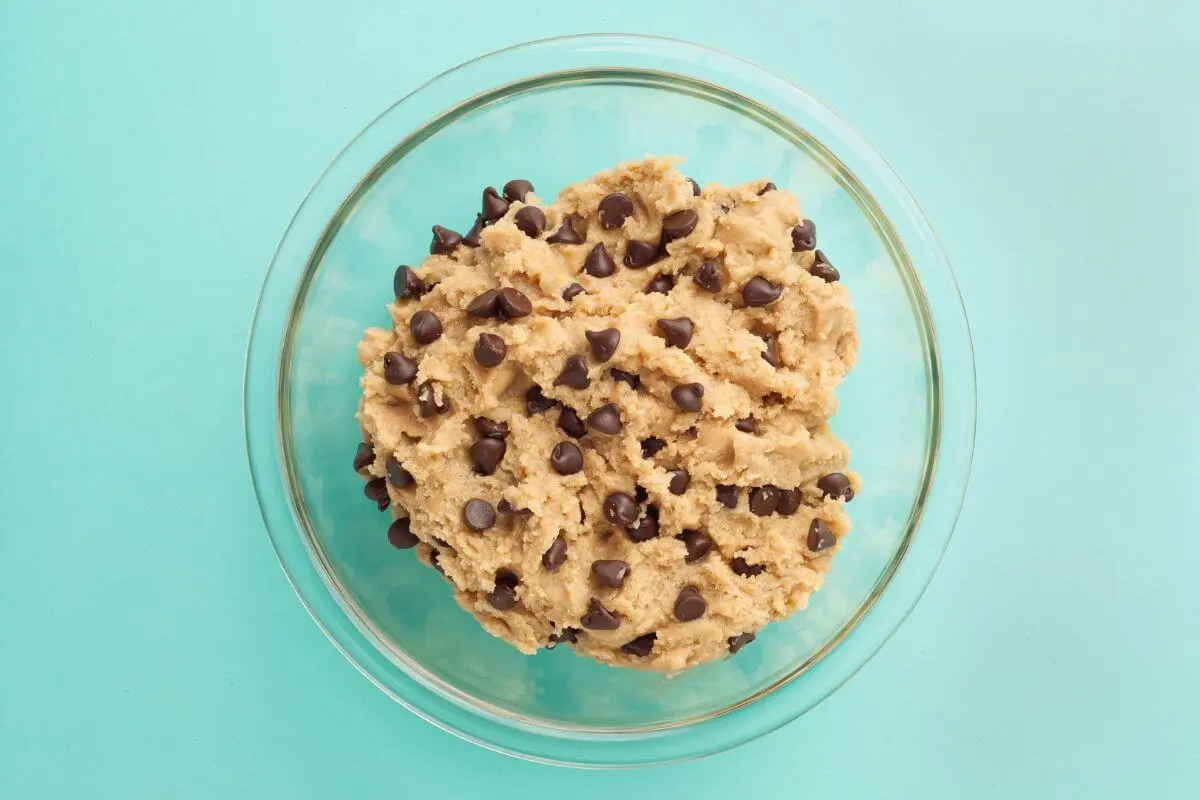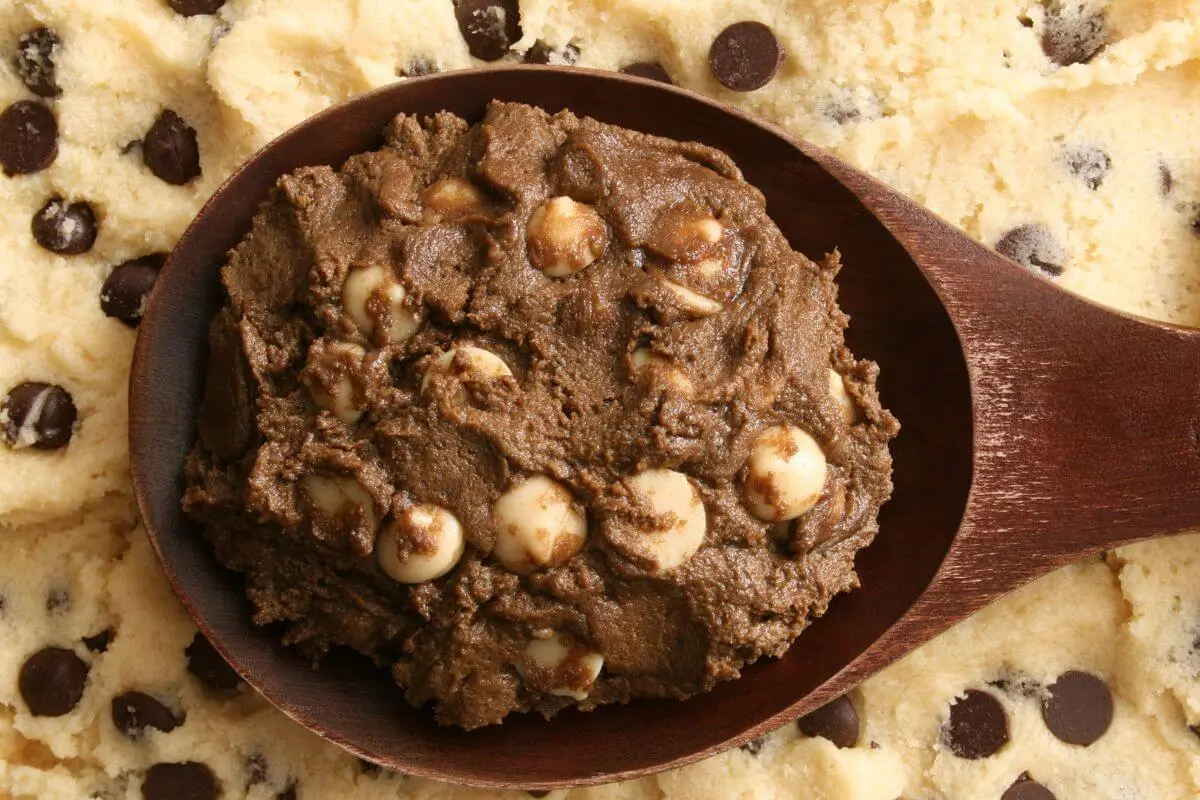Once upon a time, in the kitchens of yesteryear, the creation of cookie dough recipe marked the beginning of something magical. This concoction, simple in its essence, has traversed centuries, adapting and evolving with each generation. Initially, cookies were merely a test batch for oven temperatures, but oh, how they’ve become so much more! Today, cookie dough stands as a beloved treat in its own right, cherished by folks all around the globe for its comforting sweetness and nostalgic charm.
The Joy of Homemade Cookie Dough
Making cookie dough at home is satisfying. Mixing butter, sugar, and flour creates something special. It evokes memories and brings people together. Homemade cookie dough allows for personal touches. It’s a base for endless variations, catering to all preferences.
In this article, we will explore cookie dough recipe. We’ll cover ingredients, equipment, and expert tips. So, get ready to learn about cookie dough. Each batch tells a story. Every bite is a taste of home.
Essential Ingredients and Equipment
Key Ingredients for your Cookie Dough Recipe
Every baker knows that the magic of cookie dough begins with the right ingredients. At its core, cookie dough consists of butter, sugar, and flour, but it’s the proportions and quality of these ingredients that can turn a good recipe into a great one. First, let’s consider butter, the backbone of flavor and texture. Using it at the right temperature ensures your dough has the perfect consistency. Next, sugars—both brown and white—add sweetness and depth. The molasses in brown sugar introduces moisture and a caramel-like flavor, while white sugar provides structure. Finally, flour acts as the canvas, binding everything together. For a twist, try adding a pinch of salt; it enhances all the flavors beautifully.
Must-Have Equipment for Cookie Dough Recipe
Now, onto the tools of the trade. While you might be tempted to start with just a bowl and spoon, a few key pieces of equipment can elevate your cookie dough game. A sturdy mixing bowl and a reliable electric mixer make combining ingredients a breeze, ensuring everything is evenly mixed without overworking the dough. Measuring cups and spoons are non-negotiable for precision, and a spatula will help you scrape every last bit of dough out of the bowl. Lastly, consider a cookie scoop for uniform cookies that bake evenly and look professionally made.
Ingredients:
- 1 cup of all-purpose flour
- 1 tsp of pure vanilla extract
- 1/2 cup of unsalted butter, softened
- 2 tbsp of whole milk
- 1/2 cup of semi-sweet chocolate chips
- 1/2 cup of tiny chocolate chips
- 1/2 tsp of fine sea salt
- 3/4 cup of densely packed brown sugar
These proportions are the golden ratio for creating a dough that’s both flavorful and versatile.
For safety reasons, use heat-treated flour in the recipe, as recommended by the USDA for handling raw flour.
Step-by-Step Cookie Dough Recipe Guide
Creating the perfect batch of cookie dough is an art that blends precision with a touch of whimsy. This guide takes you through the process, ensuring your cookie dough comes out splendidly every time.
Preparing Your Cookie Dough Recipe Ingredients
Before diving into the mixing, it’s crucial to have all your ingredients measured and at the right temperature. Room temperature butter is key for a smooth blend, and ensuring your flour is prepped correctly, as described earlier, safeguards your health. Gather your sugars, vanilla, salt, milk, and chocolate chips. This preparation streamlines the process, making the mixing stage a breeze.
Cookie Dough Recipe Mixing Process
- Creaming Butter and Sugars: Start by creaming the softened butter with both granulated and brown sugars in a large mixing bowl. Use your electric mixer on a medium setting for about 2-3 minutes or until the mixture is light and fluffy. This step is foundational, setting the stage for a well-aerated dough.
- Incorporating Vanilla and Salt: With the mixer still running, add in the vanilla extract and salt. These flavor enhancers are crucial for achieving that classic cookie dough taste.
- Adding Flour: Gradually add the heat-treated flour to your butter-sugar mixture. Do this step slowly, ensuring that the flour is fully incorporated without overmixing. Overworking the dough can lead to tough cookies.
- Blending in Milk: Once the dough starts to form, add the milk. This helps in bringing the dough together, ensuring it’s pliable and easy to work with. Mix just until the dough is combined and no dry flour pockets remain.
- Folding in Chocolate Chips: The final step is to gently fold in your chocolate chips, distributing them evenly throughout the dough. Whether you prefer milk, dark, or mini chips, ensure they’re woven into the dough with care to avoid breaking them.

Tips for Perfect Dough Consistency
Achieving the right consistency is key for delicious cookie dough. If your dough feels too sticky, a little extra flour can help. Conversely, if it’s too crumbly, add a splash more milk. The goal is a dough that’s soft, not sticky, and holds together well.
By following these steps, you’ll master the art of cookie dough creation, setting you up for a world of baking adventures. Whether you’re making cookies, bars, or simply enjoying a spoonful of dough, the joy of homemade cookie dough is unmatched. Remember, the best recipes are made with love and a dash of creativity. Happy baking!
Creative Variations of Cookie Dough Recipe
Delving into the realm of cookie dough variations opens up a world of flavor and texture possibilities. Indeed, this section will guide you through infusing your dough with innovative twists, thereby catering to a wide range of tastes and dietary preferences.
Black Cookie Dough Recipe with White Chocolate Chips Variation
For those looking to add a visually stunning and tastefully unique twist to their cookie repertoire, incorporating black cocoa powder into your dough, accompanied by generous handfuls of white chocolate chips, creates an unforgettable cookie dough experience. This Black Cookie Dough with White Chocolate Chips variation not only stands out in appearance but offers a delightful interplay of flavors that’s sure to impress.

Vegan Cookie Dough Alternatives
For those embracing a plant-based diet, transforming cookie dough into a vegan delight is surprisingly straightforward. Firstly, replace traditional butter with a vegan alternative that boasts a comparable fat content, ensuring the dough maintains its cherished texture. Additionally, opt for plant-based milks, such as almond or oat milk, as excellent substitutes for cow’s milk. Regarding eggs, particularly in recipes meant for raw consumption, you can simply leave them out or use a flaxseed mixture as a binder for cookies destined for the oven.
Gluten-Free Cookie Dough Recipes
Moreover, crafting a gluten-free cookie dough doesn’t mean you have to sacrifice flavor or texture. A plethora of gluten-free flours are readily available and can be used as direct substitutes for all-purpose flour. For example, almond flour not only renders your dough gluten-free but also imparts a delightful nutty flavor. It’s important to note that you might need to add xanthan gum to some gluten-free flours to replicate the texture that gluten provides.
For those interested in making their cookie dough healthier, the American Heart Association provides excellent tips on ingredient substitutions.
Fun Flavors and Add-Ins
Furthermore, the excitement truly begins when you experiment with various flavors and add-ins. Beyond the classic chocolate chip, consider incorporating white chocolate and macadamia nuts for a luxuriously decadent twist. Alternatively, for an entirely different experience, you could fold in crushed cookies, candy pieces, or even swirls of caramel or peanut butter into your cookie dough. The possibilities are endless, limited only by your imagination.
Therefore, by exploring these variations, you’re not just making cookie dough; you’re creating personalized treats that reflect your unique tastes and creativity. Whether you’re adapting the recipe for dietary reasons or simply to experiment with new flavor combinations, these tips guarantee that your cookie dough adventures remain both exciting and delectably satisfying. So, why not experiment? Your perfect cookie dough variation is just waiting to be discovered!
To continue your culinary journey and discover more delectable recipes, consider diving into the delightful world of desserts featured on our site. For instance, you might be intrigued by the Almond Joy Cookie Recipe, a perfect blend of coconut, almonds, and chocolate that brings a classic candy bar to life in cookie form. Alternatively, the Strawberry Cheesecake Cookies Recipe offers an easy yet decadent way to enjoy the flavors of strawberry cheesecake in a bite-sized treat.
Frequently Asked Questions
Navigating the delicious world of cookie dough can stir up a fair share of questions. From achieving the perfect consistency to understanding the basics of dough creation, let’s address some common inquiries that might pop up during your baking adventures.
What makes cookie dough?
At its heart, cookie dough is a blend of butter, sugars, flour, and often eggs, mixed to create a base for baking cookies. The magic lies in the balance of ingredients; butter for richness, sugars for sweetness and texture, flour for structure, and eggs for binding. Variations in these ingredients or their ratios can lead to an array of cookie dough types, suitable for different cookie styles.
How to make cookie dough with few ingredients?
For a simple cookie dough, you can stick to the essentials: flour, sugar, butter, and a pinch of salt. This base mixture can serve as a foundation, to which you can add flavors or mix-ins like chocolate chips or vanilla extract. The simplicity of ingredients doesn’t diminish the potential for delicious cookies, showcasing that sometimes, less truly is more.
How do you make cookie dough before baking?
Preparing cookie dough involves creaming together butter and sugars, adding eggs and vanilla for flavor and moisture, then gradually mixing in flour and salt until a cohesive dough forms. If your recipe calls for mix-ins like nuts or chocolate chips, fold these in last. Once your dough is prepared, it’s often recommended to chill it in the refrigerator, which helps in handling and can improve the texture and flavor of your cookies.
How to make cookie dough better?
Enhancing your cookie dough can be as simple as using high-quality ingredients, like pure vanilla extract or artisanal chocolates. Experimenting with brown butter or a mix of sugars can add depth to the flavor. Don’t shy away from a dash of gourmet salt to balance the sweetness. For an extra indulgent texture, chilling the dough before baking encourages a more pronounced flavor and prevents cookies from spreading too much in the oven.
By addressing these FAQs, we hope to have cleared up some of the mysteries surrounding cookie dough and sparked inspiration for your next baking session. Remember, baking is both an art and a science—experimentation and practice lead to perfection. So, preheat your oven, roll up your sleeves, and dive into the delightful process of bringing cookie dough to life, one batch at a time.
Wrapping up!
As we bring our exploration of cookie dough and its endless possibilities to a close, it’s evident that this beloved mixture forms the cornerstone of many delightful treats. From the simplicity of classic chocolate chip cookies to the richness of innovative desserts, cookie dough has proven to be a versatile and essential ingredient in the baking world.
Each recipe on our site, from savory dishes to sweet indulgences, is designed to inspire and excite both seasoned bakers and novices alike. So, whether you’re looking to perfect your cookie dough technique or expand your dessert repertoire, we invite you to explore the myriad of recipes available at your fingertips. Happy baking, and may your kitchen always be filled with the sweet aroma of freshly baked cookies and desserts!


3 thoughts on “Cookie Dough Recipe: The Easy Guide to Perfection”